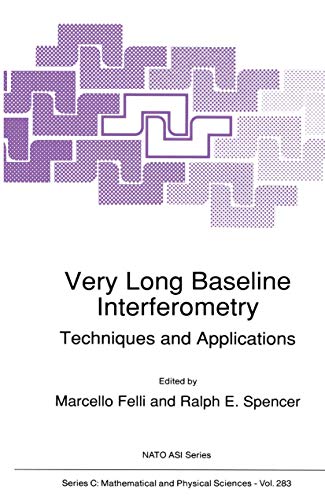Very Long Baseline Interferometry: Techniques and Applications: 283 (NATO Science Series C) - Softcover

Inhaltsangabe
The quest for high resolution has preoccupied radio astronomers ever since radio waves were first detected from space fifty years ago. This venture was par ticularly stimulated by the discovery of quasars, and led to the development of interferometer techniques using baselines of transglobal dimensions. These meth ods have become known as Very Long Baseline Interferometry (VLBI). Arrays of radio telescopes situated all over the Earth (or even in space) are regularly used for researches in radio astronomy, reaching resolutions as small as a fraction of a milli arcsecond. The technique also allows the measurement of the positions of the radio telescopes to a few millimeters and so VLBI has become a major tool in geodesy and the study of the rotation of the Earth. VLBI has now passed the pioneer stage and is becoming a standard facility available to astronomers and geodesists, requiring the coordination of the operations of indpendently owned radio telescopes around the world. In Europe observatories from England, Federal Republic of Germany, France, Italy, Poland, Sweden and The Netherlands are coordinated in their VLBI activity by the European VLBI Network Consortium (EVN). The Programme Committee of the EVN allocates time to scientific projects on a routine basis three times a year. The Unites States has a similar arrangement of a network of independent radio observatories, and joint experiments using ’Global Network’ are often made.
Die Inhaltsangabe kann sich auf eine andere Ausgabe dieses Titels beziehen.
Reseña del editor
The quest for high resolution has preoccupied radio astronomers ever since radio waves were first detected from space fifty years ago. This venture was par ticularly stimulated by the discovery of quasars, and led to the development of interferometer techniques using baselines of transglobal dimensions. These meth ods have become known as Very Long Baseline Interferometry (VLBI). Arrays of radio telescopes situated all over the Earth (or even in space) are regularly used for researches in radio astronomy, reaching resolutions as small as a fraction of a milli arcsecond. The technique also allows the measurement of the positions of the radio telescopes to a few millimeters and so VLBI has become a major tool in geodesy and the study of the rotation of the Earth. VLBI has now passed the pioneer stage and is becoming a standard facility available to astronomers and geodesists, requiring the coordination of the operations of indpendently owned radio telescopes around the world. In Europe observatories from England, Federal Republic of Germany, France, Italy, Poland, Sweden and The Netherlands are coordinated in their VLBI activity by the European VLBI Network Consortium (EVN). The Programme Committee of the EVN allocates time to scientific projects on a routine basis three times a year. The Unites States has a similar arrangement of a network of independent radio observatories, and joint experiments using 'Global Network' are often made.
„Über diesen Titel“ kann sich auf eine andere Ausgabe dieses Titels beziehen.
Weitere beliebte Ausgaben desselben Titels
Suchergebnisse für Very Long Baseline Interferometry: Techniques and Applicatio...
Very Long Baseline Interferometry : Techniques and Applications
Anbieter: AHA-BUCH GmbH, Einbeck, Deutschland
Taschenbuch. Zustand: Neu. Druck auf Anfrage Neuware - Printed after ordering - The quest for high resolution has preoccupied radio astronomers ever since radio waves were first detected from space fifty years ago. This venture was par ticularly stimulated by the discovery of quasars, and led to the development of interferometer techniques using baselines of transglobal dimensions. These meth ods have become known as Very Long Baseline Interferometry (VLBI). Arrays of radio telescopes situated all over the Earth (or even in space) are regularly used for researches in radio astronomy, reaching resolutions as small as a fraction of a milli arcsecond. The technique also allows the measurement of the positions of the radio telescopes to a few millimeters and so VLBI has become a major tool in geodesy and the study of the rotation of the Earth. VLBI has now passed the pioneer stage and is becoming a standard facility available to astronomers and geodesists, requiring the coordination of the operations of indpendently owned radio telescopes around the world. In Europe observatories from England, Federal Republic of Germany, France, Italy, Poland, Sweden and The Netherlands are coordinated in their VLBI activity by the European VLBI Network Consortium (EVN). The Programme Committee of the EVN allocates time to scientific projects on a routine basis three times a year. The Unites States has a similar arrangement of a network of independent radio observatories, and joint experiments using 'Global Network' are often made. Artikel-Nr. 9789401075954
Neu kaufen
Anzahl: 1 verfügbar
Very Long Baseline Interferometry: Techniques and Applications
Anbieter: Revaluation Books, Exeter, Vereinigtes Königreich
Paperback. Zustand: Brand New. 1989 edition. 460 pages. 9.25x6.10x1.04 inches. In Stock. Artikel-Nr. x-9401075956
Neu kaufen
Anzahl: 2 verfügbar

